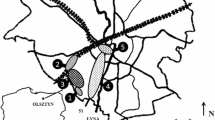Summary
Annual rings of about 100-year-old pine trees (Pinus silvestris) from two locations of the Nürnberger Reichswald were investigated. According to the chronological distribution patterns, the elements can be divided into two groups: a) elements with decreasing concentration from the older to the younger wood: Ca, Mg, Mn, Zn, Al, Pb and Cd; b) elements with increasing concentration: K, P, S, Fe, Cu and Ni. These changes of the element uptake occur at both locations almost parallel and this could be the result of two superimposed tendencies: On the one hand, it indicates increasing immission of pollutants; accordingly for several elements increasing deposition can be observed. On the other hand, sulphur dioxide causes progressive acidification of the soil and the biosphere, followed by increasing washing out of elements. The industrial development, especially the emission of sulphur dioxide, is assumed to be the cause of at least part of these effects. According to our interpretation, sulphur seems to be the key-element for understanding both tendencies.
Similar content being viewed by others
References
Bell, J. N. B., Experientia42 (1986) 363.
Francis, A. J., Experientia42 (1986) 455.
McLaughlin, S., and Bräker, O. U., Experientia41 (1985) 310.
Ulrich, B., Gefahren für das Waldökosystem, durch saure Niederschläge. LÖLF-Mitt. Sonderh. Landesanst. f Ökologie Nordrhein-Westfalen, Recklinghausen (1982) 9.
Ulrich, B., and Matzner, E., Forst-Holzwirt38 (1983) 468.
Zöttl, H. W., Experientia41 (1985) 1104.
Anonymus, Forschungsbeirat Waldschäden/Luftverunreinigungen der Bundesregierung und der Länder, 2. Bericht, Mühlacker 1986.
Meisch, H.-U., Kessler, M., Reinle, W., and Wagner, A., Experientia42 (1986) 537.
Ulrich, B., Allg. Forst-Jagdztg154 (1983) 76.
Krause, G. H. M., Jung, K. D., and Prinz, B. Neuere Untersuchungen zur Aufklärung immissionsbedingter Waldschäden. VDI-Berichte 500 (1983) 257.
Landolt, W., and Keller, Th., Experientia41 (1985) 301.
Prinz, B., Krause, G. H. M., and Jung, K.-D., in: Effects of Atmospheric Pollutants on Forests, Wetlands and Agricultural Ecosystems, p. 1–24. Eds T. C. Hutchinson and K. M. Meema. NATO ASI Series G16, Berlin 1987.
Zech, W., and Popp, E., Forstw. Cbl.102 (1983) 50.
Ulrich, B., Meiwes, K. J., König, N., and Khanna, P. K., Forst-Holzwirt39 (1984) 278.
Woolhouse, H. W., in: Physiological Plant Ecology. III. Responses to the Chemical and Biological Environment. Encyclopedia of Plant Physiology, New Series, vol. 12C, p. 245. Eds O. L. Lange, P. S. Nobel, C. B. Osmond and H. Ziegler. Springer-Verlag, Berlin 1977.
Hüttermann, A., Experientia41 (1985) 584.
Matzner, E., and Ulrich, B., Experientia41 (1985) 578.
Baes, C. F., and McLaughlin, S. B., Science24 (1984) 494.
Schrimpff, E., Natur Landschaft55 (1980) 460.
Herrmann, R., Neuland, H., and Buss, G., Staub-Reinhalt. Luft38 (1978) 366.
Isermann, K., Bewertung natürlicher und anthropogener Stoffeinträge über die Atmosphäre als Standortfaktoren im Hinblick auf die Versauerung land- und forstwirtschaftlich genutzter Böden. VDI-Bericht 500 (1983) 307.
Rorison, I. H., Experientia42 (1986) 357.
Reigber, E., and Braun, G., Forstliche Bioindikatoruntersuchungen in Bayern — Methodik und erste Ergebnisse 1981/82 Schriftenr. d. Forstwiss. Fak. d. Univ. München u. d. Bayer. FVA,68 (1985).
OECD, The OECD programme on long range transport of air pollutants. OECD, Paris (1977); cit. from Ulrich4.
Höllwarth, M., Angew. Bot.58 (1984) 21.
Peterson, L., Experientia42 (1986) 340.
Grünhage, L., and Jäger, H.-J., Angew. Bot.62 (1988) 85.
Ulrich, B., and Matzner, E., Experientia42 (1986) 344.
Isermann, K., Aluminium- und Schwermetall-Gehalte im Holzzuwachs von Waldbäumen im Solling (Bundesrepublik Deutschland) seit 1860 bis 1980. Vortrag: Tagung der Deutschen Botanischen Gesellschaft, Wien 1984.
Author information
Authors and Affiliations
Rights and permissions
About this article
Cite this article
Tendel, J., Wolf, K. Distribution of nutrients and trace elements in annual rings of pine trees (Pinus silvestris) as an indicator of environmental changes. Experientia 44, 975–980 (1988). https://doi.org/10.1007/BF01939892
Received:
Accepted:
Published:
Issue Date:
DOI: https://doi.org/10.1007/BF01939892




